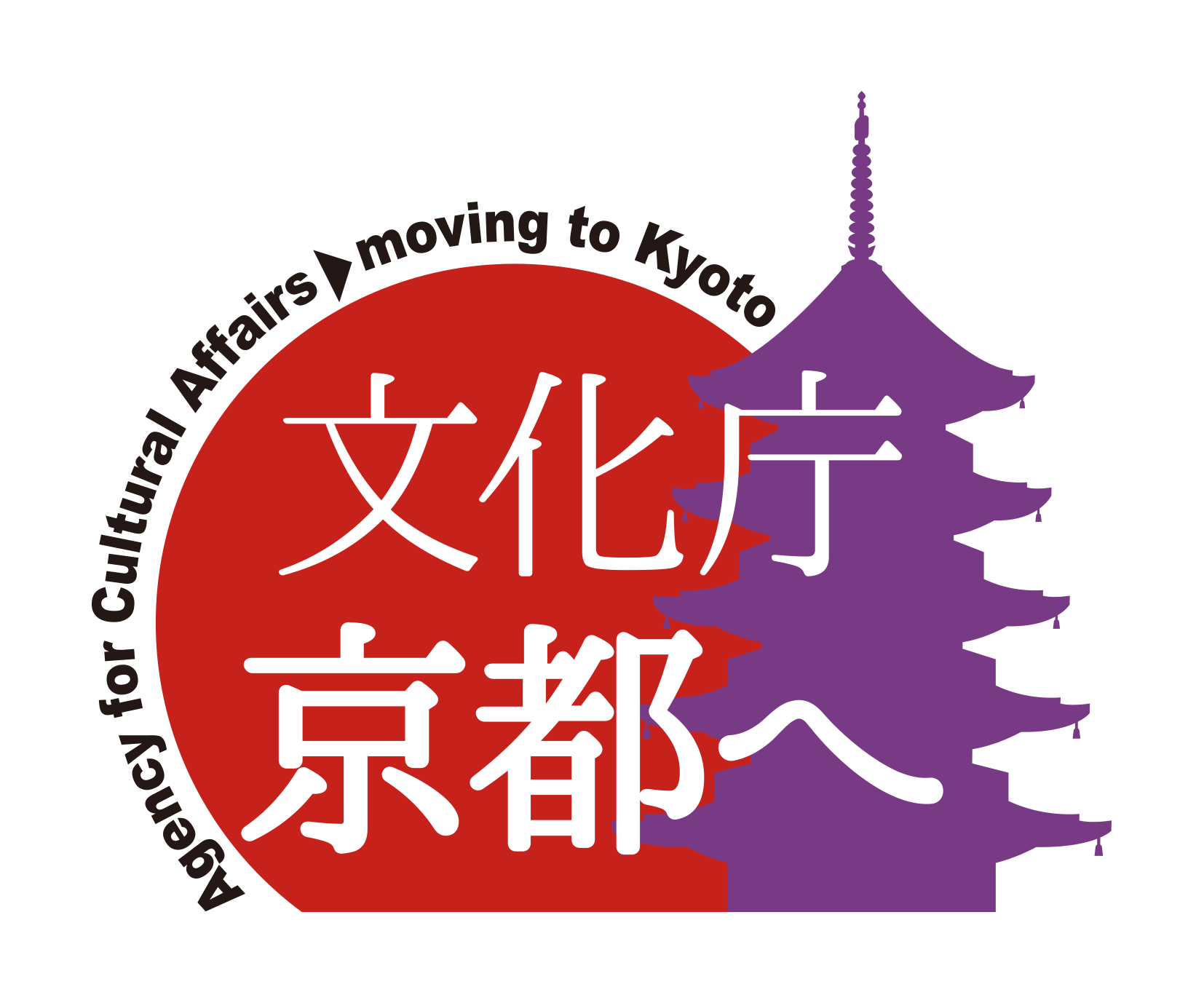Girls Career Talk in Kyoto
~Thinking about the way women live in the future~
Modern society expects women to play an active role, and the government is implementing various initiatives with the aim of “creating a society in which all women shine.” As an approach to high school and female university students who will be the leaders of the future and who are making career choices in the future, the first question should be “What kind of jobs are there in society?” and “Is it really possible to balance work and family?” In order to face and respond to such simple questions and anxieties, the Kyoto High School-University Collaborative Research Council and the High School Consortium Kyoto invite women from various industries who are actually active in society to listen to their diverse career experiences, talk together, and hold a project in which Mr./Ms., a female high school student and female university student, thinks about her future.
We are looking forward to receiving applications from all Mr./Ms. of female high school and female university students in the Mr./Ms..
Outline of the event
| Date |
Saturday, February 14, 2015 13:30~16:00 |
| Venue |
Campus Plaza Kyoto 2nd Floor Hall |
| Organizer |
Kyoto High School University Collaborative Research Council
(Kyoto Prefectural Board of Teachers, Kyoto City Board of Education, Kyoto Prefectural Federation of Private Junior and Senior High Schools, Kyoto Chamber of Commerce and Industry, University Consortium Kyoto)
High School Consortium Kyoto |
| Target |
Approximately 30 female students enrolled in high schools and universities in Kyoto Prefecture |
| Participation Fee |
free |
| Contents |
(1) Lecture
Lecturer: Kazumi Sawada (Career Counselor)
Theme: Thinking about the Future Me (tentative)
* We will receive advice from an expert’s perspective, such as the status of women’s social advancement and career transitions unique to women.
(2) Group discussion
Small-group discussions with working guests (doctors, nurses, architects, high school teachers, kimono artists, etc.) and high school and university students
* We invite women who work wonderfully in various fields to give advice and answer questions based on actual experience.
(3) Summary and questionnaire filling out |
Girls Career Talk in Kyoto
~Thinking about the way women live in the future~

How to apply: E-mail application
Subject: “Girls Career Talk in Kyoto”
Body: (1) Name (2) Affiliated university/faculty/high school affiliation (3) Grade (4) Telephone number (5) E-mail address
Please apply by e-mail to kodai■consortium.or.jp with the above contents.
(Please replace ■ with @)
We will send you a confirmation email after receiving your application.
Application Deadline
Friday, February 6, 2015
* If there are many applications, a lottery will be held.
*Reception hours: Tuesday ~ Saturday 9:00 ~ 17:00
Application and Inquiries
University Consortium Kyoto High School-University Collaboration and Internship Division
Tel: 075-353-9153 FAX: 075-353-9101
〒600-8216 Shimogyo-ku, Kyoto-shi, Nishitoin-dori, Shiokoji, Shimo-ku, Kyoto, Campus Plaza Kyoto
* Reception hours: Tuesday ~ Saturday 9:00 ~ 17:00 (excluding year-end and New Year holidays)
In fiscal 2015, we will hold the “Kyoto University Learning Forum” again. Participate in mock lectures and
hands-on courses at universities in Kyoto and experience learning in various fields!
Mr./Ms.Not only high school students, but also parents and high school teachers are welcome to attend.
At the booths and resource corners of each university, you can consult with them about everything from small questions about university life to specific matters such as academic fields. Other courses and courses for parents are also planned.
It is a great opportunity to learn about what you learn at university. Please invite your friends and come with your family again!
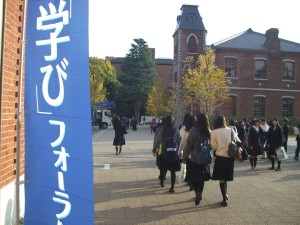 ✿Date/Venue for 2015✿
✿Date/Venue for 2015✿
Date: Sunday, October 25, 2015
9:30~16:00 (tentative)
Venue: Ritsumeikan University, Kinugasa Campus
〒603-8577 56-1 Tomochiin Kitamachi, Kita-ku, Kyoto
Access to the venue
Organizer: Kyoto High School-University Collaborative Research Council
(Kyoto Prefectural Board of Education, Kyoto City Board of Education,
Kyoto Prefectural Federation of Private Junior and Senior High Schools
Kyoto Chamber of Commerce and Industry and University Consortium Kyoto)
*Held on Sundays
★ ☆State of FY2014☆ ★
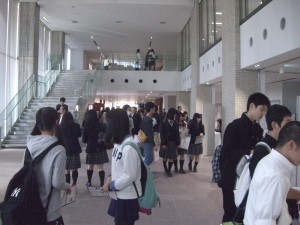
Reception
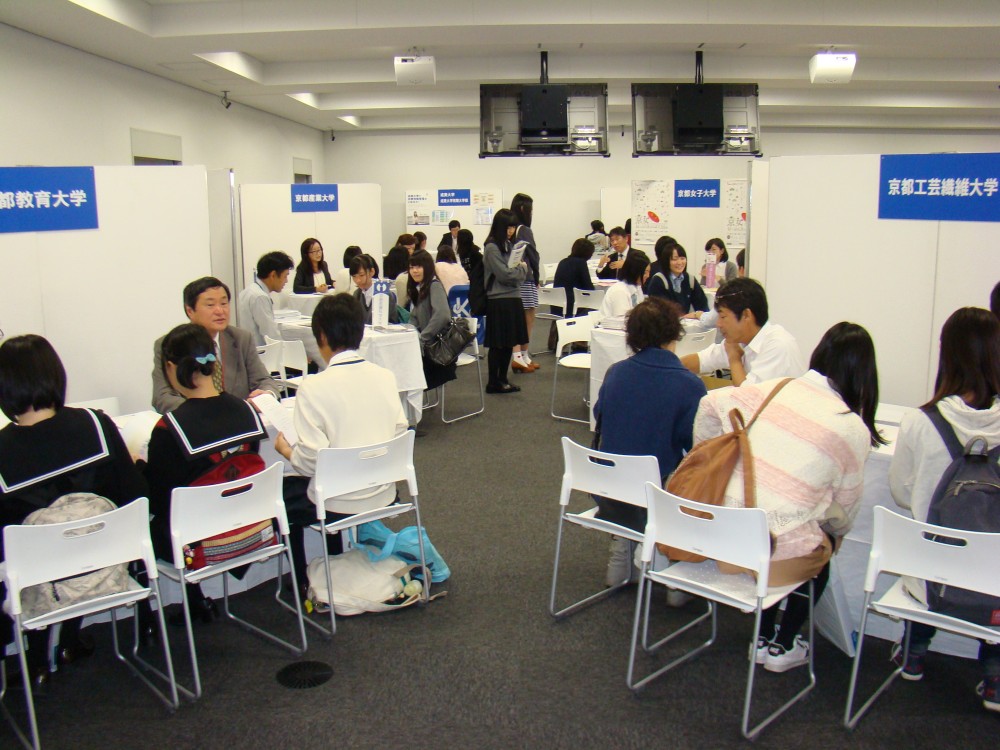
University Booths
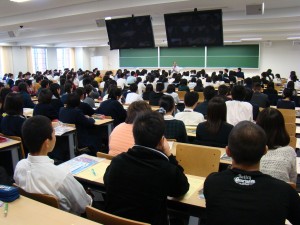
Mock Lectures
★ ☆ Voices of 2014 participants (high school students and parents) ☆ ★
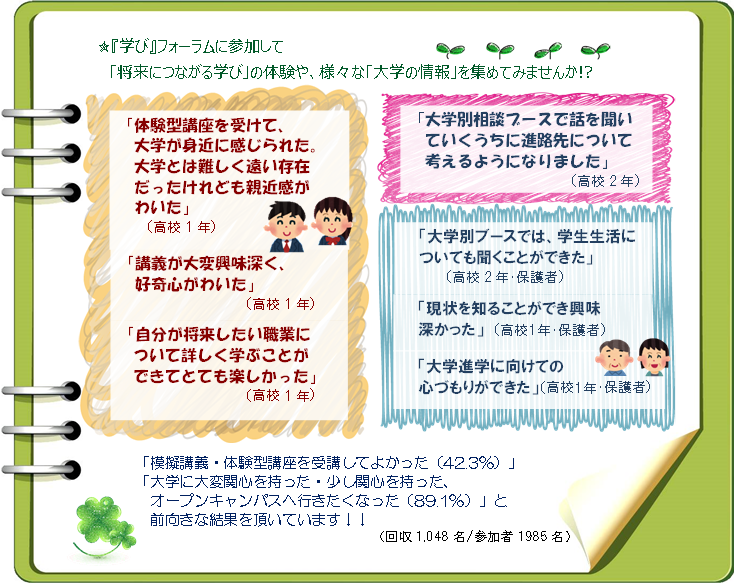
————————————————————————————————-
We are currently considering a more substantial project for fiscal 2015.
Please join us at the 2015 Learning Forum!
————————————————————————————————-
✿2014 Kyoto University “Learning” Forum

✿ For high school students and their parents, University Consortium Kyoto page (project)

Inquiries
University Consortium Kyoto Learning Forum
TEL: 075-353-9153 E-mail: manabiforum@consortium.or.jp
〒600-8216 Shimogyo-ku, Kyoto-shi, Nishitoin-dori, Shiokoji, Shimo-ku, Kyoto, Campus Plaza Kyoto
* Reception hours: Tuesday ~ Saturday 9:00 ~ 17:00 (excluding year-end and New Year holidays)
Kyoto FDer School sponsored by the University Consortium Kyoto.
In order to train faculty and staff who will become leaders in FD activities at the member schools of the University Consortium Kyoto, the seminar is mainly aimed at faculty and staff who are FD committee members and FD administrative staff at each university and junior college. We look forward to your participation.
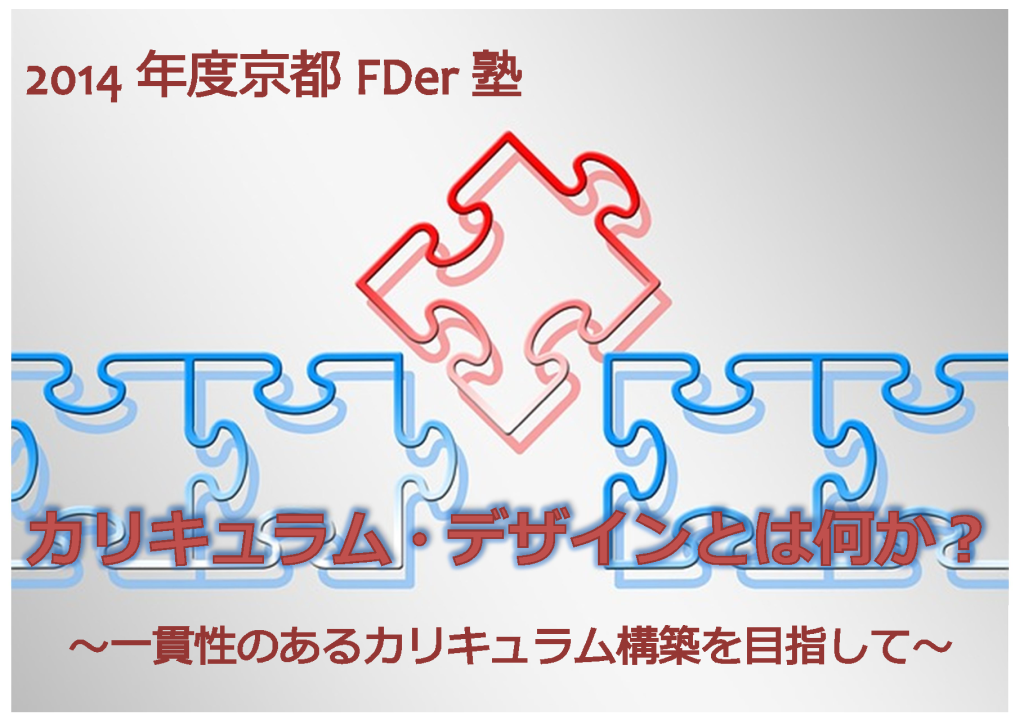
2014 Kyoto FDer School What is Curriculum Design?
~Aiming to build a consistent curriculum~
Outline of the event
| Date |
Saturday, January 24, 2015 13:00~17:00 (Doors open at 12:30) |
| Venue |
Campus Plaza Kyoto, 5th Floor, Lecture Room 1 |
| Target |
University faculty, staff, and the general public who are interested in FD |
| Occupancy |
150 (first-come, first-served basis) |
| Participation Fee |
For members of member schools: Free
Non-members: ¥1,000 (Please pay at the reception on the day) |
Lecture Outline
| theme |
What is Curriculum Design?
~Aiming for a Consistent Curriculum Design~ |
| Overview |
In recent years, Japan’s higher education has been required to shift to an organizational and systematic curriculum based on diploma policies and curriculum policies.
Although each university has been tackling various issues through educational reform and FD, it is said that society is still dissatisfied with the current progress in improving undergraduate education.
The most important aspect of undergraduate education as a program is policy-based curriculum design.
How can we shift from the traditional teacher-centered curriculum to an organized and systematic curriculum?
Also, how should specialized education and so-called general education be positioned in the curriculum offered at each university, and how should they be related?
Based on this awareness of the problem, we will share the process and content of the discussion during this period from the precedents of universities that have specifically worked on curriculum reform, and we will provide an opportunity for participants to obtain hints on the optimal decision-making process and problem solving at their home universities. |
| Keynote Speeches |
“Curriculum Formation for Realizing DP”
Tatsuo Kawashima (Professor, Institute for Future Strategies, Osaka University)
|
| Case Studies |
Kenji Furuya (Professor, Institute of Basic Education, Kyushu University) |
| Nobuko Kawahara (Professor, Faculty of Nursing, Kyoto Tachibana University) |
| Shigeo Kikuchi (Dean, Professor, Tamagawa University) |
| Chairperson |
Takashi Yasuoka (Professor, Institute for Educational Development, Ritsumeikan University) |
Information flyer [2014 FDer cram school information flyer]
How to apply: E-mail application
Subject: “0124 Kyoto FDer Juku Application”
Text: (1) Name (2) University affiliation (3) Faculty, staff, general (4) E-mail address
Please send an e-mail to fdrd■consortium.or.jp with the above contents. (Please replace ■ with @) We will send you a confirmation email after receiving your application.
About Kyoto FDer School

Inquiries
University Consortium Kyoto FD Project
TEL 075-353-9163 FAX 075-353-9101
〒600-8216 Shimogyo-ku, Kyoto-shi, Nishitoin-dori, Shiokoji, Shimo-ku, Kyoto, Campus Plaza Kyoto
* Reception hours: Tuesday ~ Saturday 9:00 ~ 17:00 (excluding year-end and New Year holidays)
In a situation where the environment surrounding universities is changing rapidly, the management and operation of universities has come to occupy an important position, and the role of university staff is becoming extremely important. In order to adapt to such an environment, we are developing a variety of projects to improve the qualifications of university staff, including management and education and research support.
In the SD workshop, students will make new discoveries, deepen their awareness, and create a network of human exchange that cannot be obtained through lectures through discussions with colleagues from other companies in the same industry (staff from other universities).
If you are interested in trends in higher education policy, if you work with student staff or part-time students, or if you are interested in the “reflection” that is currently in vogue, please join us.

Outline of the event
| Venue |
Campus Plaza Kyoto |
| Organizer |
University Consortium Kyoto |
| Target |
If you are a university employee (non-university staff (faculty member, etc.), please contact us in advance. ) |
| Participation Fee |
Member Universities |
JPY 1,000 |
| Non-Member Universities |
JPY 2,000 |
| Capacity |
20 |
Session 3: Staff Promoting Student Growth ~Beginning of Reflection Utilization~
| schedule |
Saturday, December 20, 2014 13:00~17:00 |
| Topic Provision |
Takamichi Murayama (Director, Academic Affairs Division, Kyoto Bunkyo University) |
workshop
Coordinator |
Kiyo Kawakami (Research Fellow, University Consortium Kyoto) |
| Application Deadline |
Monday, December 15, 2014 |
| substance |
 |
Registration (first-come, first-served):
3rd SD Workshop: Monday, December 15, 2014
SD Workshop Application
(10th) 2014 Kyoto Studies Lecture “Traveling in Kyoto ~Sightseeing Gaze~”

The first hotel in Kyoto was Nakamuraya in Gion, which opened in the first year of the Meiji era (1868). Later, in Meiji 21 (1888), Kyoto Tokiwa, which followed the current Kyoto Hotel, opened in Kamogawa Nijo Ohashi Nishizume. Kyoto Tokiwa received the payment of the ruins of the government facility in Kawaramachi Nijo, and restarted in Meiji 23 (1890) as a newly built Western-style hotel as KIOTO HOTEL. The fact that Crown Prince Nicholas of Russia stayed at this hotel and encountered the Otsu incident was a major international event. In 1925, the first Rotary club in Kyoto was established at the Kyoto Hotel. We will focus on the history of hotels in Kyoto that have progressed with the times.
| Date |
Saturday, December 6, 2014 10:30~12:00 |
| Venue |
Campus Plaza Kyoto 5th Floor, Lecture Room 1 |
| Lecturer |
Ikuo Ooka (Kyoto Hotel Co., Ltd.)
Born in Tokyo in 1948. 1975 / Joined Shiga Kogen Hotel in Nagano Prefecture, 1976 / Kyoto Hotel. After serving banquet services and banquet sales, he worked in the computer introduction preparation room. After working in the Electronic Calculation Division and the Accounting Section, he participated in the complete reconstruction of the Kyoto Hotel in the Business Planning Division. 1994 / General Manager of Sales Promotion Department, 2001 / Director, General Manager of Tokyo Sales Department, 2003 / General Manager of the President’s Office, 2005 / General Manager of Sales Promotion Department,
2006 / General Manager of Karasuma Kyoto Hotel, 2007 / General Manager of the Audit Office, 2010 / Organizational Operation and Management, 2012 / Managing Director.
|
Application
Tuition fee: 1,500 yen (1 time)
* How to apply: Please apply at the venue on the day of the event.
* Free of charge for full-time students (excluding graduate students, majors, and correspondence course students) of the University Consortium Kyoto member universities and junior colleges, as well as all non-degree students enrolled in the Open University of Japan Kyoto Study Center.
How to apply: Please apply at the venue on the day of the event. It is not possible to apply for practical courses.
The 2014 Kyoto College “Kyoto Studies Course” will be held until Saturday, December 6.
Inquiries
University Consortium Kyoto, Department of Kyoto Studies
TEL 075-353-9140 FAX 075-353-9121
〒600-8216 Shimogyo-ku, Kyoto-shi, Nishitoin-dori, Shiokoji, Shimo-ku, Kyoto, Campus Plaza Kyoto
* Reception hours: Tuesday ~ Saturday 9:00 ~ 17:00 (excluding year-end and New Year holidays)
University Festival
With mock shops, exhibitions, appearances by cultural figures, singers, and celebrities, and performances by each club circle, university students are enlivening their own university, and you can experience a different university atmosphere. We look forward to your participation.
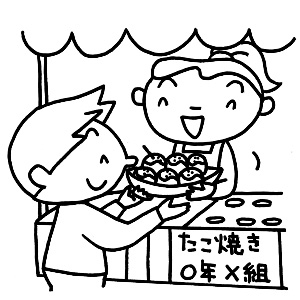

The 12th Kyoto Student Festival
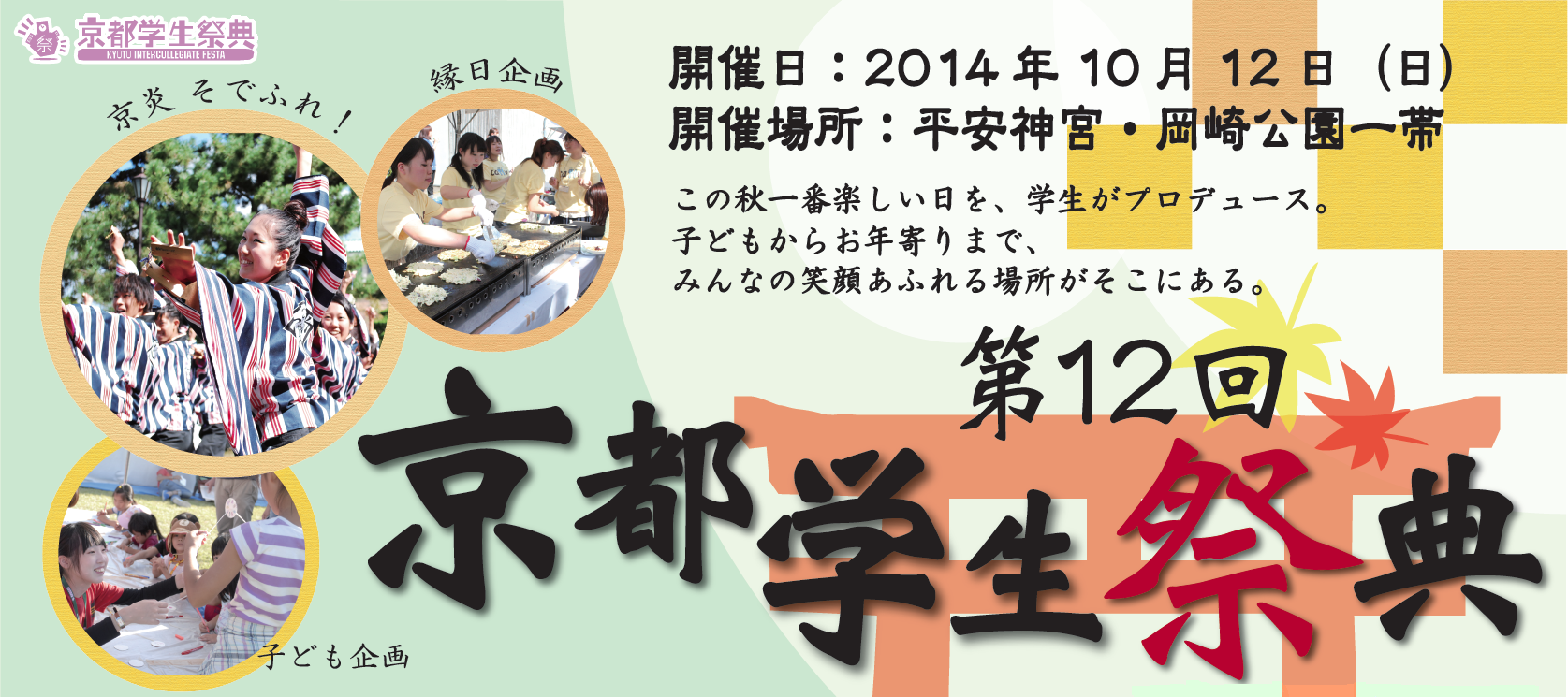
| Date |
Sunday, October 12, 2014 11:00~20:20 |
| Venue |
Heian Jingu Shrine and Okazaki Park |
| Organizer |
Kyoto Student Festival Executive Committee |
| Co-organizers |
Kyoto Student Festival Organizing Committee (Kyoto Prefecture / Kyoto City / Kyoto Chamber of Commerce and Industry / Kyoto Association of Corporate Executives / University Consortium Kyoto) |
| Special Cooperation |
Heian Shrine |
| Cooperation |
NHK Kyoto Broadcasting Station |

On the occasion of the 20th anniversary of the Foundation, the University Consortium Kyoto has decided to expand the number of participants in the “Kyoto FD Executive School,” which is usually held for university executives, and to hold a grand lecture to commemorate the 20th anniversary.
In recent years, the role of university executives has become increasingly important in improving university education, and we hope that you will participate in this commemorative lecture as an opportunity to learn about the situation surrounding universities, not only for university executives but also for those who are not directly involved in university management.
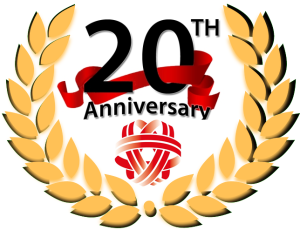
Outline of the event
| Date |
Saturday, November 22, 2014 10:30~12:20 |
| Place: |
Campus Plaza Kyoto Lecture Room 2 |
| Target |
Educational Professionals |
| Occupancy |
30 (first-come, first-served basis) |
| Participation Fee |
free |
Lecture Outline
| Thesis |
“Toward the development of human resources with the ability to open up the future ~The next 20 years when universities and high schools will take on challenges together~” |
| Lecturer |
Takayuki Shioze
(Former Assistant Director, Industrial Technology Policy Division, Ministry of Economy, Trade and Industry, Associate Professor in charge of Technology History, Kyoto University Museum) |
| Overview |
In the era of human resource mobility, where it is no longer the norm to work for 40 years, the skills required of human resources have changed significantly. The mere ability to memorize and accurately reproduce the wisdom of our ancestors is no longer sufficient. In such a society, where the answer is not known in the first place, and where the relationship between value and worthlessness is unstable and can change quickly, it is important to have an attitude toward “unknowingness.” There is a need for human resources who can identify their own strengths and weaknesses in response to changes in value and continue to relearn.
In order to continue to support Japan, which is transitioning from a period of high economic growth to a period of maturity, we must first recognize our position as one of a society of 7 billion people with diverse cultures and values, which is clearly different from the era when only a few countries in Japan, the United States, and Europe led the country. It is the responsibility of the university-high school partnership to accept the diversity of human resources, cultures, and values that are truly necessary, and to produce human resources who can face unexplored social issues and turn the power of diverse specialists into breakthroughs. |
| Instructor Biography |
1998 Graduated from the Department of Precision Engineering, Graduate School of Engineering, Kyoto University. He has served as an assistant professor at the Graduate School of Science and Technology, Kobe University, an assistant professor at the Graduate School of Informatics, Kyoto University, and an associate professor at the Kyoto University Museum. Since July 2012, he has been working as an assistant manager in charge of technology strategy at the Industrial Technology Policy Division of the Ministry of Economy, Trade and Industry. In July 2014, he returned to work as an associate professor at the Museum of Medicine, Kyoto University. He has given numerous lectures on career education in elementary, junior high, and high schools, innovator development training in companies, and the transfer of skilled skills. |
How to apply: E-mail application
Describe the following contents,
Please apply to fdrd■consortium.or.jp. (Please replace ■ with @.) )
Subject: 20th Anniversary Lecture Application
Body: (1) Name (2) Name of affiliated institution (3) Separation of faculty and staff (4) E-mail address
Inquiries
University Consortium Kyoto FD Project
Contact Person: TEL 075-353-9163 FAX: 075-353-9101
〒600-8216 Shimogyo-ku, Kyoto-shi, Nishitoin-dori, Shiokoji, Shimo-ku, Kyoto, Campus Plaza Kyoto
* Reception hours: Tuesday ~ Saturday 9:00 ~ 17:00 (excluding year-end and New Year holidays)
(9th) 2014 Kyoto Studies Lecture “Traveling in Kyoto ~The Gaze of Tourism~”

Tourists come to Kyoto in a wide range of ages, from children to the elderly, and many of them come frequently because they admire the charm of Kyoto in all four seasons. In addition, about 1 million students come on school trips annually as repeat customers in the future. Our guide association is a tourist guide in Kyoto for Japan tourists, and we would like to contribute to the increase in tourists in Kyoto in the future by conveying the state of tourists and the charm of the guide through daily guides.
| Date |
Saturday, November 22, 2014 10:30~12:00 |
| Venue |
Campus Plaza Kyoto 5th Floor, Lecture Room 1 |
| Lecturer |
Shinichi Ukawa (Kyoto SKY Tourist Guide Association)
Born in Osaka in 1944, moved to Kyoto after the war and graduated from Fushimi High School. In 2004, after retiring from a financial institution, he joined the Guide Association. In 2011, he became Vice President of the Kyoto SKY Tourist Guide Association. In 2013, he became the president of the Kyoto SKY Tourist Guide Association.
|
Application
Tuition fee: 1,500 yen (1 time)
* How to apply: Please apply at the venue on the day of the event.
* Free of charge for full-time students (excluding graduate students, majors, and correspondence course students) of the University Consortium Kyoto member universities and junior colleges, as well as all non-degree students enrolled in the Open University of Japan Kyoto Study Center.
How to apply: Please apply at the venue on the day of the event. It is not possible to apply for practical courses.
The 2014 Kyoto College “Kyoto Studies Course” will be held until Saturday, December 6.
Inquiries
University Consortium Kyoto, Department of Kyoto Studies
TEL 075-353-9140 FAX 075-353-9121
〒600-8216 Shimogyo-ku, Kyoto-shi, Nishitoin-dori, Shiokoji, Shimo-ku, Kyoto, Campus Plaza Kyoto
* Reception hours: Tuesday ~ Saturday 9:00 ~ 17:00 (excluding year-end and New Year holidays)
(8th) 2014 Kyoto Studies Lecture “Traveling in Kyoto ~The Gaze of Tourism~”

From the end of the Middle Ages to the beginning of the early modern period, what we now call “landmarks” appeared. Kyoto came to be seen as a city full of these “famous places”, and shrines and temples became the center. Media that invites you to “famous places” also appear one after another. It is a pilgrimage mandala, a map of the Rakuchu Rakugai, a description of the landmarks, and a guide. While introducing such media, we will trace the development of “famous places” and the spread of travel, using Kiyomizu-dera Temple as a typical example.
| Date |
Saturday, November 1, 2014 10:30~12:00 |
| Venue |
Campus Plaza Kyoto 5th Floor, Lecture Room 1 |
| Lecturer |
Teruhisa Sakai (Curator, Kiyomizu-dera Temple)
Born in Fukui Prefecture in 1948. Graduated from the Faculty of Letters, Kyoto University. In 1973, he joined the Kyoto Shimbun and served as Director of the Cultural Affairs Department of the News Bureau and a member of the editorial board of the Cultural News Department of the News Bureau. After serving as an advisor for the revitalization of Kyoto City from April 2009, he became the curator of Kiyomizu-dera Temple from April 12. |
Application
Tuition fee: 1,500 yen (1 time)
* How to apply: Please apply at the venue on the day of the event.
* Free of charge for full-time students (excluding graduate students, majors, and correspondence course students) of the University Consortium Kyoto member universities and junior colleges, as well as all non-degree students enrolled in the Open University of Japan Kyoto Study Center.
How to apply: Please apply at the venue on the day of the event. It is not possible to apply for practical courses.
The 2014 Kyoto College “Kyoto Studies Course” will be held until Saturday, December 6.
Inquiries
University Consortium Kyoto, Department of Kyoto Studies
TEL 075-353-9140 FAX 075-353-9121
〒600-8216 Shimogyo-ku, Kyoto-shi, Nishitoin-dori, Shiokoji, Shimo-ku, Kyoto, Campus Plaza Kyoto
* Reception hours: Tuesday ~ Saturday 9:00 ~ 17:00 (excluding year-end and New Year holidays)
(7th) 2014 Kyoto Studies Lecture “Traveling in Kyoto ~The Gaze of Tourism~”

With the development of the modern railway network, the postal system, and the media, ethnic events and performing arts in various regions have been “discovered” and “hometowns” have been created. In the Showa 50s, the Japanese National Railways (JNR) “Discovery Japan” once again made people aware of their “hometown” and “hometown”. Among them, Kyoto will become a major tourist attraction based on the image of “the hometown of Japan”. I would like to think together with Mr. Mr./Ms. about the relationship between the history of technology and the history of media in the historical background of tourism, and the relationship between Kyoto, Kyoto tourism, and folkloism.
| Date |
Saturday, October 18, 2014 10:30~12:00 |
| Venue |
Campus Plaza Kyoto 5th Floor, Lecture Room 1 |
| Lecturer |
Toshihiko Saito (Associate Professor, Department of History and Culture, Faculty of History, Bukkyo University)
Born in Hyogo Prefecture in 1971. Withdrew from the doctoral program at the Graduate School of Letters, Bukkyo University. Ph.D. (Literature). He is the author of “Early Modern Kamigata Kabuki and Sakai” (2012, Shibunkaku Publishing), “Early Modern Sakai and Kabuki” (2009, Osaka Metropolitan University Joint Press), and co-author of “Once Upon a Time in Kyoto” (2006, Heibonsha). |
Application
Tuition fee: 1,500 yen (1 time)
* How to apply: Please apply at the venue on the day of the event.
* Free of charge for full-time students (excluding graduate students, majors, and correspondence course students) of the University Consortium Kyoto member universities and junior colleges, as well as all non-degree students enrolled in the Open University of Japan Kyoto Study Center.
How to apply: Please apply at the venue on the day of the event. It is not possible to apply for practical courses.
The 2014 Kyoto College “Kyoto Studies Course” will be held until Saturday, December 6.
Inquiries
University Consortium Kyoto, Department of Kyoto Studies
TEL 075-353-9140 FAX 075-353-9121
〒600-8216 Shimogyo-ku, Kyoto-shi, Nishitoin-dori, Shiokoji, Shimo-ku, Kyoto, Campus Plaza Kyoto
* Reception hours: Tuesday ~ Saturday 9:00 ~ 17:00 (excluding year-end and New Year holidays)
![]()






























